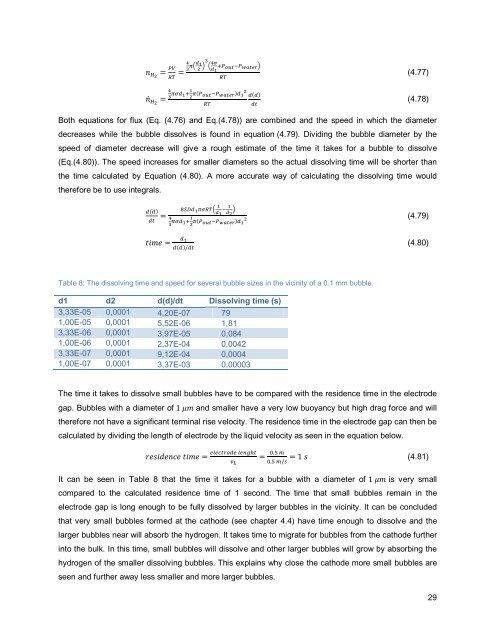A bubble curtain model applied in chlorate electrolysis
A bubble curtain model applied in chlorate electrolysis
A bubble curtain model applied in chlorate electrolysis
Create successful ePaper yourself
Turn your PDF publications into a flip-book with our unique Google optimized e-Paper software.
n H2 = PV<br />
4<br />
= 3 πd 1<br />
2 3 4σ<br />
d1 +P out−P water <br />
RT RT<br />
ṅ H 2<br />
=<br />
4<br />
3 πσd 1+ 1 2 π(P 2<br />
out−P water )d 1 d(d)<br />
RT<br />
dt<br />
(4.77)<br />
(4.78)<br />
Both equations for flux (Eq. (4.76) and Eq.(4.78)) are comb<strong>in</strong>ed and the speed <strong>in</strong> which the diameter<br />
decreases while the <strong>bubble</strong> dissolves is found <strong>in</strong> equation (4.79). Divid<strong>in</strong>g the <strong>bubble</strong> diameter by the<br />
speed of diameter decrease will give a rough estimate of the time it takes for a <strong>bubble</strong> to dissolve<br />
(Eq.(4.80)). The speed <strong>in</strong>creases for smaller diameters so the actual dissolv<strong>in</strong>g time will be shorter than<br />
the time calculated by Equation (4.80). A more accurate way of calculat<strong>in</strong>g the dissolv<strong>in</strong>g time would<br />
therefore be to use <strong>in</strong>tegrals.<br />
d(d)<br />
dt<br />
=<br />
8SDd 1 πσRT 1<br />
d1 − 1<br />
d2 <br />
4<br />
3 πσd 1+ 1 (4.79)<br />
2 π(P 2<br />
out−P water )d 1<br />
time = d 1<br />
d(d)/dt<br />
(4.80)<br />
Table 8: The dissolv<strong>in</strong>g time and speed for several <strong>bubble</strong> sizes <strong>in</strong> the vic<strong>in</strong>ity of a 0.1 mm <strong>bubble</strong>.<br />
d1 d2 d(d)/dt Dissolv<strong>in</strong>g time (s)<br />
3,33E-05 0,0001 4,20E-07 79<br />
1,00E-05 0,0001 5,52E-06 1,81<br />
3,33E-06 0,0001 3,97E-05 0,084<br />
1,00E-06 0,0001 2,37E-04 0,0042<br />
3,33E-07 0,0001 9,12E-04 0,0004<br />
1,00E-07 0,0001 3,37E-03 0,00003<br />
The time it takes to dissolve small <strong>bubble</strong>s have to be compared with the residence time <strong>in</strong> the electrode<br />
gap. Bubbles with a diameter of 1 μm and smaller have a very low buoyancy but high drag force and will<br />
therefore not have a significant term<strong>in</strong>al rise velocity. The residence time <strong>in</strong> the electrode gap can then be<br />
calculated by divid<strong>in</strong>g the length of electrode by the liquid velocity as seen <strong>in</strong> the equation below.<br />
residence time =<br />
electrode lenght<br />
v L<br />
It can be seen <strong>in</strong> Table 8 that the time it takes for a <strong>bubble</strong> with a diameter of 1 μm is very small<br />
compared to the calculated residence time of 1 second. The time that small <strong>bubble</strong>s rema<strong>in</strong> <strong>in</strong> the<br />
electrode gap is long enough to be fully dissolved by larger <strong>bubble</strong>s <strong>in</strong> the vic<strong>in</strong>ity. It can be concluded<br />
that very small <strong>bubble</strong>s formed at the cathode (see chapter 4.4) have time enough to dissolve and the<br />
larger <strong>bubble</strong>s near will absorb the hydrogen. It takes time to migrate for <strong>bubble</strong>s from the cathode further<br />
<strong>in</strong>to the bulk. In this time, small <strong>bubble</strong>s will dissolve and other larger <strong>bubble</strong>s will grow by absorb<strong>in</strong>g the<br />
hydrogen of the smaller dissolv<strong>in</strong>g <strong>bubble</strong>s. This expla<strong>in</strong>s why close the cathode more small <strong>bubble</strong>s are<br />
seen and further away less smaller and more larger <strong>bubble</strong>s.<br />
29<br />
=<br />
0,5 m<br />
0,5 m/s<br />
= 1 s (4.81)















